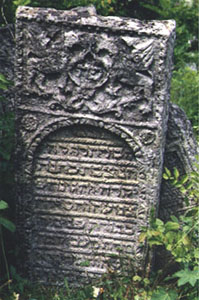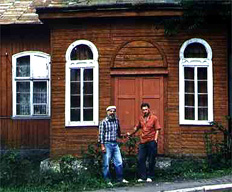Since the
early 1990s, the Center for Jewish Art has been conducting expeditions to the Ukraine,
once one of the flourishing centers of East European Jewry, to document the remnants of
Jewish art there: sacred and ceremonial objects, synagogues and cemeteries.
The expedition team to the Ukraine in August 1997
set out to further explore and document the cemeteries and synagogue architecture of the
shtetls and towns in the regions of Galicia and Volyn in northwest Ukraine. This
expedition revealed two important finds. The first is a wooden synagogue in Skhodnitsa,
Galicia, probably the only remaining wooden synagogue in the Ukraine. The second is a
cemetery located in the town of Kremenets, which includes 120 tombstones from the
sixteenth to eighteenth centuries.
In addition to their Jewish iconography, tombstones
are invaluable documents of Jewish community life. From their details chiseled in stone,
researchers gather illuminating information regarding Jews of previous eras: their social
status, the structure and size of Jewish families, patterns of birth and life-expectancy,
trends in marriage as well as crafts and professions practiced by Jews. A cemetery thus
reflects the life of the community, and since the world of East European Jewry was
devastated, cemeteries often serve as the best documents of this by-gone world. |

17th century tombstone with animal motif in
Kremenets, Ukraine.
|
One of the first stops on this
expedition was the town of Kremenets, one of the oldest Jewish communities of Volyn,
dating back to the fourteenth century. This very cultured and prosperous community played
an important role in the economy of the town until World War II. In the eighteenth century
leaders of the Hasidic and Haskalah movements resided here. Over 6,500 Jews lived
here on the eve of the Holocaust, from which only fourteen survived. Today there are no
Jews, and the remaining synagogue is used as a bus station. The town has the look of a
typical Jewish-Polish shtetl. However, most of what remains of the vibrant Jewish life of
Kremenets exists only in a photographic collection in the local historical museum, which
was examined by researchers. |
| A large cemetery sits on a
hill overlooking the town. The old section of the cemetery is in a state of deterioration,
with some of the tombstones crumbling, and engravings legible on seventy-five percent of
the remaining tombstones. Researchers documented fifty tombstones from the sixteenth
century, and seventy from the seventeenth and eighteenth century, some of which were
beautifully decorated with animal and flower motifs, a very rare find in tombstones of the
early seventeenth century. Newer tombstones with unusual motifs were also documented, such
as a nineteenth century tombstone with a pitcher motif, designating the tombstone of a
Levite. |
 This late 19th century synagogue in Skhodnitsa, is probably the only remaining wooden synagogue in the Ukraine. This late 19th century synagogue in Skhodnitsa, is probably the only remaining wooden synagogue in the Ukraine.
|
It was believed that all wooden
synagogues of the Ukraine were destroyed, and so researchers were quite surprised and
delighted to come upon a wooden synagogue thirty kilometers from Drogobich, Galicia, in
the town of Skhodnitsa. The design of this synagogue is very similar to other wooden
synagogues, with an external gallery, high roof and twelve windows. This late nineteenth
century synagogue is one story tall and has external signs of what was once a women's
gallery. The synagogue was in use until World War II, and has been used since as a sewing
factory. The synagogue was probably saved because the town is small and remote. Today no
Jews nor any other trace of Jewish life exists in Skhodnitsa. |
| The town of Korets was once
a well-known center of Hasidism. Four important Hebrew printing presses were established
there in the eighteenth century contributing to the spread of Hasidism. At the end of the
nineteenth century Jews comprised over seventy-five percent of the population. When the
Soviets entered Korets in 1939, Jewish institutions and political parties were disbanded.
Most of the remaining Jews were murdered or dispersed after the Germans entered Korets in
1941. The only trace of this once important Jewish community, is part of a cemetery with
only six remaining tombstones. Four of these are from the seventeenth century and one is
decorated.
Novograd Volinsky, another town
which once claimed a thriving Jewish community, has several typically Jewish homes and a
new cemetery. Our research team visited three other towns but found no sign of Jewish
life: Kostopol, Berezne, and Veliki Mezhirichi.
Having carried out seven years of surveys and
expeditions to the Ukraine, researchers of the Center for Jewish Art have documented a
major portion of the vast material culture of this once important Jewish center. Yet to be
completed is the documentation of important cemeteries in southern Galicia, and synagogues
in Eastern Ukraine, which researchers hope to carry out in the near future.
This expedition was carried out
with the generous support of the Fanny and Leo Koerner Charitable Trust, Cambridge,
Massachusetts. The expedition was also assisted by grants from the Samuel Mandell
Foundation, Pennsylvania, and the Charles and Lynn Schusterman Family Foundation,
Oklahoma.
|

 This late 19th century synagogue in Skhodnitsa, is probably the only remaining wooden synagogue in the Ukraine.
This late 19th century synagogue in Skhodnitsa, is probably the only remaining wooden synagogue in the Ukraine.



